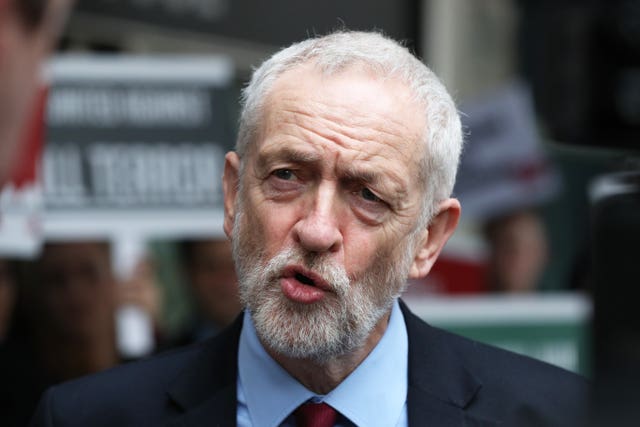Prime Minister Theresa May is bringing her Withdrawal Agreement to the Commons for a vote on Friday – the day the UK had been scheduled to quit the EU.
– How is this different from previous votes?
MPs will only be voting on part of Prime Minister Theresa May’s Brexit deal, not the whole thing.
The Commons will consider the Withdrawal Agreement (WA), which is the legally binding “divorce deal” and covers the UK’s exit from the EU.
READ MORE: Theresa May accused of 'trickery' as half of Brexit deal put to vote
MPs will not vote on the Political Declaration (PD) element which is non-legally binding and looks at the future relationship Britain will have with the bloc.
– What does the WA cover?
 John Bercow said the Brexit deal needed to be substantially different before being brought before the Commons again (Yui Mok/PA)
John Bercow said the Brexit deal needed to be substantially different before being brought before the Commons again (Yui Mok/PA)
The WA deals with matters such as the transition period after the UK formally leaves the EU.
It contains proposals for the controversial Northern Irish backstop which is intended as an insurance policy to prevent the return of a hard border on the island of Ireland.
And it deals with issues like the financial settlement and citizens’ rights after withdrawal.
– Why has the Prime Minister chosen to do it in this way?
The move ensures the Government complies with a ruling by Commons Speaker John Bercow that it could not present the Brexit deal to the Commons again for approval unless it was substantially different from previous efforts.
Splitting the two elements of the deal means the Government meets the Speaker’s demands after the full Brexit package was heavily defeated by MPs on two occasions.
 Jeremy Corbyn, (Jonathan Brady/PA)">Labour leader Jeremy Corbyn said he will vote against it (Jonathan Brady/PA)
Jeremy Corbyn, (Jonathan Brady/PA)">Labour leader Jeremy Corbyn said he will vote against it (Jonathan Brady/PA)
However, the move does not let Parliament go ahead and ratify the withdrawal deal because Brexit legislation only allows this after the passage of a so-called “meaningful vote” on both the Withdrawal Agreement and a Political Declaration on the future relationship.
– What impact would the result have on the UK’s exit date from the EU?
If passed by MPs, the vote would qualify the UK to be granted an automatic delay to May 22 of the formal date of Brexit.
If the motion is rejected, the UK will have until April 12 to ask for a further extension to Brexit negotiations – which would require voters to choose new MEPs at May elections – or leave the EU without a deal.
READ MORE: Scottish Parliament votes to revoke Article 50 and cancel Brexit
– What are the chances of the Commons backing the PM?
Both the DUP and Labour have said they will vote against the agreement.
This means the Government is dependent on winning over enough hardline members of the European Research Group of Tory MPs and Labour backbenchers to achieve success.
While Mrs May’s statement that she would stand down if she gets her Brexit deal through Parliament has caused a number of prominent Tory Eurosceptics to offer support, other hardline Brexiteers remain opposed to the agreement.



Why are you making commenting on The Herald only available to subscribers?
It should have been a safe space for informed debate, somewhere for readers to discuss issues around the biggest stories of the day, but all too often the below the line comments on most websites have become bogged down by off-topic discussions and abuse.
heraldscotland.com is tackling this problem by allowing only subscribers to comment.
We are doing this to improve the experience for our loyal readers and we believe it will reduce the ability of trolls and troublemakers, who occasionally find their way onto our site, to abuse our journalists and readers. We also hope it will help the comments section fulfil its promise as a part of Scotland's conversation with itself.
We are lucky at The Herald. We are read by an informed, educated readership who can add their knowledge and insights to our stories.
That is invaluable.
We are making the subscriber-only change to support our valued readers, who tell us they don't want the site cluttered up with irrelevant comments, untruths and abuse.
In the past, the journalist’s job was to collect and distribute information to the audience. Technology means that readers can shape a discussion. We look forward to hearing from you on heraldscotland.com
Comments & Moderation
Readers’ comments: You are personally liable for the content of any comments you upload to this website, so please act responsibly. We do not pre-moderate or monitor readers’ comments appearing on our websites, but we do post-moderate in response to complaints we receive or otherwise when a potential problem comes to our attention. You can make a complaint by using the ‘report this post’ link . We may then apply our discretion under the user terms to amend or delete comments.
Post moderation is undertaken full-time 9am-6pm on weekdays, and on a part-time basis outwith those hours.
Read the rules here